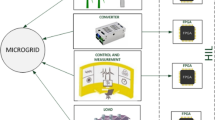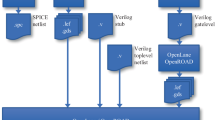Abstract
We propose a configurable and scalable architecture targeted for the implementation of advanced wireless communication algorithms based on matrix computations. A design methodology for programming and configuring the processor architecture is developed. The design entry point is the representation of the algorithm in Matlab/Simulink. The Simulink description is parsed and the algorithm’s Dependence Flow Graph is derived, which is scheduled and space–time mapped onto the proposed architecture. The compiler reconfigures the switch boxes of the proposed hierarchical interconnection network in the architecture. An energy consumption model is derived, and design examples are provided that demonstrate the enhanced energy efficiency of the proposed architecture compared to a state of the art programmable VLIW DSP processors.
Similar content being viewed by others
References
B. Hassibi, “An Efficient Square-Root Algorithm for BLAST,” Proc. IEEE Int. Conf. Acoust. Speech Signal Proc., vol. 2, 2000, pp. 737–740.
C. M. Rader, “VLSI Systolic Arrays for Adaptive Nulling,” IEEE Signal Process. Mag., vol. 13, July 1996, pp. 29–49.
S. Haykin, Adaptive Filter Theory, Prentice Hall, 1996.
X. Wang and H. V. Poor, “Blind Multiuser Detection: A Subspace Approach,” IEEE Trans. Inf. Theory, vol. 44, no. 2, March 1998, pp. 677–690.
D. J. Rabideau, “Fast, Rank Adaptive Subspace Tracking and Applications,” IEEE Trans. Signal Process., vol. 44, no. 9, September 1996, pp. 2229–2244.
S. Y. Kung, VLSI Array Processors, Prentice Hall, 1988.
J. Rabaey, “Silicon Platforms for the Next Generation Wireless Systems—What Role Does Reconfigurable Hardware Play?,” Proceedings FPL 2000, Austria, August 2000.
K. K. Parhi, VLSI Digital Signal Processing Systems, Wiley, 1999.
K. Sarrigeorgidis and Jan Rabaey, “Ultra Low Power CORDIC Processor for Advanced Wireless Communication Algorithms,” J. VLSI Signal Process., vol. 38, 2004, pp. 115–130.
K. Sarrigeorgidis, “Massively Parallel Reconfigurable Wireless Processor Architecture and Programming,” Ph.D Thesis, U.C.Berkeley, Dec 2002.
J. Heiskala et al., OFDM Wireless LANs: A Theoretical and Practical Guide, Sams, 2002.
A. Paulraj, R. Nabar, and D. Gore, Introduction to Space–Time Wireless Communications, Cambridge, 2003.
A. Salvekar et al., “Multi-Antenna Technology in WiMAX Systems,” Intel Technol. J., vol. 8, no. 3, Aug 2004, pp. 229–239.
S. Verdu, Multiuser Detection, Cambridge, 1998.
G. Golub and C. Van Loan, Matrix Computations, Third Edition, Johns Hopkins, 1996.
H. Zhang et al., “A 1 V Heterogeneous Reconfigurable Processor IC for Baseband Wireless Applications,” International Solid State Circuits Conference, Feb. 2000, pp. 68–69.
A. Abnous and Jan Rabaey, “Ultra-Low-Power Domain Specific Multimedia Processors,” in Proc. IEEE VLSI Signal Processing Workshop, Oct. 1996, pp. 461–470.
B. Salefski and L. Caglar, “Re-configurable Computing in Wireless,” in Design Automation Conf., Las Vegas, June 2001, pp. 178–183.
W. Davis et al., “A Design Environment for High Throughput, Low Power, Dedicated Signal Processing Systems,” IEEE J. Solid-State Circuits, vol. 37, no. 3, March 2002.
J. Proakis, Digital Communications, Third Edition, McGraw-Hill, 1995.
J. S. Walther, “A Unified Algorithm for Elementary Functions,” Proc. Spring Joint Computer Conf., 1971, pp. 379–385.
V. Poor and X. Wang, “Code-Aided Interference Suppression for DS/CDMA Communications—Part II: Parallel Blind Adaptive Implementations,” IEEE Trans. Commun., vol. 45, no. 9, Sept 1997, pp. 1112–1122.
B. Yang and J. Bohme, “Rotation-base RLS Algorithms: Unified Derivations, Numerical Properties and Parallel Implementations, ”IEEE Trans. Signal Process., vol. 40, May 1992, pp. 1151–1166.
J. Shepherd and J. Hudson, “Parallel Weight Extraction from a Systolic Adaptive Beamformer,”in Proc. IMA Conf. Math. Signal Processing, 1988.
P. Pango and B. Champagne, “On the Efficient use of Givens Rotations in SVD-Based Subspace Tracking Algorithms,” in Signal Process., vol. 74, no. 3, May 1999, pp. 253–277.
Z. Hui, M. Wan, V. George, and J. Rabaey, “Interconnect Architecture Exploration for Low Energy Reconfigurable Single-Chips DSPs,” Proceedings of the WVLSI, Orlando, FL, USA., April 1999.
T. Leighton, Introduction to Parallel Algorithms and Architectures, Morgan Kaufmann, 1993.
Author information
Authors and Affiliations
Corresponding author
Rights and permissions
About this article
Cite this article
Sarrigeorgidis, K., Rabaey, J. A Scalable Configurable Architecture for Advanced Wireless Communication Algorithms. J VLSI Sign Process Syst Sign Image Video Technol 45, 127–151 (2006). https://doi.org/10.1007/s11265-006-9762-9
Received:
Revised:
Accepted:
Published:
Issue Date:
DOI: https://doi.org/10.1007/s11265-006-9762-9




